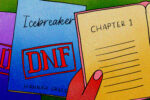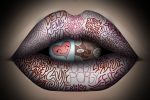One of the early chapters of “In the Dream House” describes a habit the narrator’s girlfriend refuses to change: She buys too much produce. The fridge, bursting with leafy greens and thick roots, first smells like rain, then like rot. “There is something sensual about it,” writes the author, “almost erotic, until everything begins to go bad.”
“In the Dream House” by Carmen María Machado (author of the acclaimed short-story collection “Her Body and Other Parties”) could be summed up by that sentence. The memoir explores the author’s experience of being in an abusive relationship. In doing so, it outlines the architecture of the Dream House, both as a physical place — Machado’s girlfriend’s house, a cabin in Bloomington — and an emotional space. The book braids together techniques from memoirs, essays, historical research and fairy tales in order to explore the gray areas of abuse. Machado brilliantly captures the specific terror of watching a life-long fantasy sour and turn into horror.
The book takes on a series of inventive formal experiments. For example, each chapter follows a naming convention: “Dream House as…” Some chapter titles include Dream House as Noir, Dream House as Self-Help Best Seller, Lipogram, Cautionary Tale. Other titles play directly into their titular genres, and some deconstruct them. A few of the titles refuse the characterization altogether and use it as a jumping point to explore a specific episode of the relationship.
The book is also sprinkled with more than 50 footnotes, many referencing Stith Thompson’s “Motif-Index of Folk-Literature.” When recalling a night with her girlfriend, for example, Machado annotates the passage “Midnight comes” with the following note: “Thompson, Motif-Index of Folk-Literature, Type C752.1, Taboo: doing thing after sunset (nightfall).” The device works as a running gag, though it also gives the text an eerie quality. It magnifies the resonances of certain actions and hints at a parallel world where the pain felt by Machado is legible, tangible and as ripe as a fruit.
The author once wrote that she found it difficult to conceive of her relationship as abusive because she hadn’t encountered narratives of queer domestic abuse before. Without context or precedents, she wasn’t able to make sense of her situation. However, by bringing her experience into the register of fairy tales, she deconstructs the pain of that punctured dream. As Machado writes, “Fantasy is … the defining cliché of female queerness.”
The discussion surrounding a missing archive is central to the mission of “In The Dream House.” Machado is, after all, entering her story into a non-existent archive. This is not because domestic violence in queer couples is rare — it is “as common as dirt” — but because, historically, these are the stories left out of the narrative, at times “never uttered in the first place.” Even today, Machado argues that queer people feel pressured to perform virtue, and progressives continue to steer away from the mere suggestion that queer couples are capable of violence. It’s a reflex born from the constant fight for rights: When media narratives demonize you, radical honesty is bad PR.
“In The Dream House” is a formally ambitious book, although it is not a politically ambitious one. Its rationale simply does not feel radical today — especially not in a golden age of queer representation, or in the aftermath of marriage equality legislation. In that sense, the book is less a leading force, and more a reflection of the cultural changes since Machado’s youth.
These reflective tendencies also extend to some of the book’s formal choices. Like “Weather” by Jenny Offill or “The Argonauts” by Maggie Neilson, “In The Dream House” is comprised of over 140 short, fragmented sections, a trendy literary style that has been criticized by authors like Lauren Oyler as “melodramatic … hollow prose.” Readers of Machado’s first book, “Her Body And Other Parties,” will agree that this is a less subtle, easier-to-access book. But maybe it lacks that subtlety because its subject matter of domestic abuse is inevitably blunt. And, in the end, even critics like Oyler concede that the modern experience of time is fragmented — and that, at times, these fragments allow us to puncture through certain emotional facts that are otherwise inaccessible.
In any case, the shattering of normal narratives allows Machado to pry open the uncertainty surrounding this relationship. It is also what allows the book to have such a chilling, magnetic effect. When the text becomes hostile, for example — in a chapter titled “Dream House as Choose Your Own Adventure” — the reader feels as gaslit and frustrated as Machado felt during the years of abuse.
How do you tell an impossible story? Human relationships are comprised of a thousand small gestures. One can arrange all of them in many ways and never actually get closer to the truth. With “In The Dream House,” Machado succeeded at conveying the horror at the core of the situation. Through the memoir’s dream-like atmosphere and its formal experiments, she has committed to the page the pain of seeing the dream house shed its skin and turn into a prison — and the feeling of, eventually, finding a way out.
IF YOU OR SOMEONE YOU KNOW IS EXPERIENCING DOMESTIC ABUSE, CALL OR TEXT THE NATIONAL DOMESTIC VIOLENCE HOTLINE: 1-800-799-SAFE (7233).
















